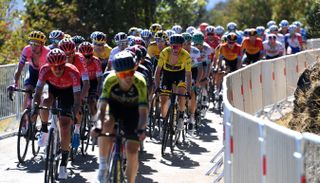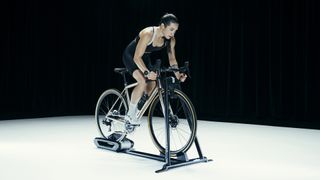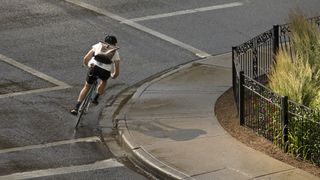I don't like to blow my own horn, but I am quite an expert cyclist. I've written books about it and everything – published books. Over the years I've acquired many of the advanced skills needed to survive and thrive on the road, be it commuting, touring, in competitive events, or cycling just for the hell of it.
There are certain mistakes everyone makes with bikes, a topic I wrote about previously on T3.com. More usefully, there are also 7 skills every cyclist should master and I am going to reveal them to you today. After all, you can buy the best road bike in the world and bolt a state-of-the-art bike computer to it, but if you have all the gear and no idea, you're never going to cut it in cycling circles.
1. Riding in a group/holding a wheel

Maybe start with a slightly smaller group than this
This is one of the first skills to master as a rider and one that can be quite nerve wracking at first. Being able to ride in a group, nice and neat, just inches behind the rider in front is a accomplishment that grows with time. Riding like this keeps the bunch tidy on the road and will also saves energy as you will be sitting tight in the slipstream of the rider in front.
There really is no other way to learn this other than to practice. The best way to do that is join a cycling club with experienced riders and go on their weekend club runs. Here you will be surrounded by people you can trust to hold a steady straight line, allowing you to perfect the technique in a safe and controlled environment.
Key things to remember are these: don’t make sudden movements, keep your eyes ahead to look for changes in pace and your hands on the brakes to react in good time. Never grab the brakes too hard or this can cause a chain reaction behind just stay relaxed, alert and as close the wheel in front without overlapping or touching it.
2. Riding out of the saddle

You can even practice this at home with the right kit
This is a skill that will really help when tacking extreme gradients, or launching a sprint. Again, like riding in a bunch the key is practice although this is a technique you can practice solo. Find a nice steep hill, engage a slightly larger gear than normal so there is more resistance when you push down, stand up on the pedals and then swing the bike rhythmically from side to side. Rock left when your right legs pushes down and rock right when your left leg pushes down. It may help to watch how pro riders do this; then you can mimic their movement to help you perfect your swing.
3. Cornering

Textbook stuff, marvellous
When it comes to taking corners like a pro, there are a few key things to consider, to get you off on the right foot. Most important of these are entry speed and when to brake.
You want to enter the corner at the speed you feel comfortable rounding it – you don't want to be braking on the bend itself as this is where you are more likely to loose traction.
For fast, downhill corners place your hands on the drops – the bottom part of your bars – to lower your centre of gravity and keep your fingers near the levers, just in case. Do not pedal through fast corners. Instead, keep your inside leg at the top of the pedal stroke and your outside leg at the bottom to maximise pedal clearance. Finally chose the best line you can ride if you have the space and the road is clear by starting wide, heading for the apex then exiting wide. This will minimise the angle of the corner, allow you to carry more speed through it or just make it easier to navigate. Do keep an eye out for other road users, though.
The good news is that your cornering skills will grow as your confidence does.
4. Taking your hands off the bars

Top of the world, ma! Top of the world!
There will come a time once you’ve started riding that you will need to take your hands off the bars. Perhaps just one at first in order to take a drink or retrieve some food from your pockets. Or, if you are old school, to make a hand signal that you are turning left or right. Or that one where you flap your arm to indicate you're braking.
If you are nervous about taking both hands off then practice on a quiet, empty road first. Start by lifting a hand off and getting a feel for controlling the bike and keeping it moving in a straight line. Once you can do that, advance to removing your water bottle or fiddling in your pockets.
Once you’ve cracked one hand, you’ll want to try no hands, but this takes a bit more practice. In an ideal world you will have mastered this as a fearless 8 year old but if you haven't, your main obstacle will be nerves.
The first time you sit upright – and it does help to sit up bolt upright, right above the pedals– it will feel very disconcerting. You will have to use your legs, feet and torso to balance and adjust the bike instead of your arms. The keys is to trust yourself, trust your bike, try and make slight gentle movements and learn how it feels; how the bike reacts under you. Stay calm, stay confident and before long you’ll be able to pedal while you remove your jacket, fold it up and probably even iron it, with practice. Maybe.
5. Riding in cycling shoes

Progressing from a standard flat pedal is a big moment in any rider’s progression. I recommend you sit on your bike at home, lent against a wall and practice the twist of the foot required to nail the release. Clip in, twist out, clip in, twist out again and again to get a feel for the pressure needed to trigger the release. Then take it to the road and repeat.
The action needs to be instinctive and totally natural because when faced with a sudden stop or obstacle, unclipping needs to be subconscious and automatic. If not, you’ll be on your back side in the grass!
Advanced information: confusingly, clip-in cycling shoes are used with 'clipless pedals' – as in ones that don't have toe clips and straps attached to them, to hold your foot in place.
6. The track stand

No, not like this
More popularly known as 'balancing on the spot', this is called the track stand’ because it’s what pursuit sprinters racing in velodromes do during a race to force their opponent into moving first. It is essentially the skill of balancing your bike on the spot with both feet still clipped in.
This is far easier on a fixed-wheel track bike as you have total control over the rear wheel to rock back and forth, because there is no free wheel. On a road bike it takes a degree more skill, the key is to find a small imperfection or a slope to rest the front wheel on, this will allow it to remain steady as you then try and hold your balance by applying just enough pressure through your cranks to hold the back wheel steady.
The track stand is most useful at traffic lights and looks pretty impressive. Although obviously if you lose balance and topple over, that will look the exact opposite if impressive, so master the skill in private first.
7. Fixing punctured tyres

This is a fun job that all riders love
Although there is the option of tubeless, self sealing tyres now, one fundamental cycling skill is to be able to fix a puncture – the number one pitfall of riding.
First of all, you should always have with you tyre levers, a spare inner tube and a pump. If you have a flat remove your wheel, fully deflate the inner tube then use the levers remove the tyre from the rim. Extract the tube then, before you do anything else, check the tyre by running your fingers inside it to see if the object that caused the puncture is still stuck in the tyre.
Once you have checked the inside, check the outside too, to make sure there is nothing embedded in the rubber. You could use a patch at this point if you are old school but believe me, replacing the entire tube is much easier.
Place the tyre back on the rim, pump a little air into the tube to give it form and insert it. Starting from the valve now pull on the other side of the tyre working round, making sure the tube is not getting trapped between the tyre and rim and try if you can to fully pull the tyre on without using the levers. If you have to use levers to get the tyre on the rim there is a high chance of pinching the tube, resulting in another puncture so be very careful.
Once the tyre is on double check the tube is completely inside it and not sticking out anywhere then inflate to the required pressure. Job done.


